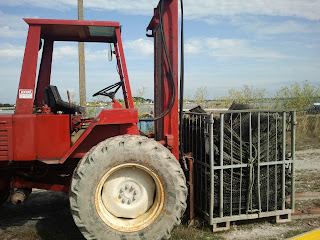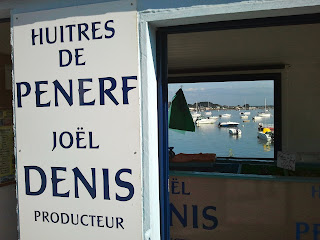The business of raising oysters is not something that has been particularly close to my heart up until now. They don't really 'do' it for me. Don't get me wrong, I love seafood, adore mussels and clams but I just can't get the oyster thing. I desperately want to love them - nothing sexier than sharing a dozen oysters sat on the sea front with a chilled bottle of something dry and white. Low in calories, good for the libido, sensuous, what more can I say. I've tried but I don't get the thrill of that saline hit as they slide down your throat. So when I say I love mussels, clams etc I guess I have to come clean, it's all about the sauce for me. Nothing better than a creamy curry flavoured mouclade with a glass of Muscadet, a bowl of steaming moules marinières with crusty bread to mop up the juices, a garlicky spagetti alla vongole. I think you get my drift - so why the interest now then?
Well, we've just come back from a short break in Brittany and paid a visit to a very pretty little seaside village called Penerf. Here, oysters rule the show. The surrounding marshes used to produce ample quantities of sea salt in generations gone by but with the land reclining, the introduction of refrigeration and the need to regenerate the area in the mid 19th century the region turned it's hand to rearing oysters.
Today there are 5 producers in this tiny village. Around the Golfe du Morbihan there are around 150 so oysters pretty much rule the roost in these parts. We took the chance to visit the production site of Jöel Denis and see what's it's all about.
Jöel is close to retirement and he doesn't have anyone lined up to take over his business. In the past, oyster rearing passed from generation to generation but it's exceedingly hard work and other more modern problems have recently appeared that make it financially crippling. A virus that originated in Russia frequently attacks the young oysters when they're young. Some years the producers will suffer a 10% loss and other years it can be up to 80%.
Each producer effectively rents a parcel of sea from the state for a period of 35 years. If things don't work out and the producer decides to call it quits he/she has to pay for a minimum of 10 years rent. This is one reason why the majority of producers try to buy existing businesses from the retirement generation as otherwise they are faced with the heavy investment costs of setting up a production facility themselves and then persuading the state to rent them an area of sea. But with the virus wiping out a good proportion of the oysters before they can reach full maturity, you can see why this business is proving unattractive to the younger generation.
These tiny oysters are a few months old and have been bought in by Jöel Denis. Young oysters like this cost 30€ per kilo (now they don't sound expensive do they?). He puts around 700 of them in large plastic mesh bags (see below on the tractor) and then these are laid out on tables in the sea. The bags weigh about 25 kilos each and are turned and shaken on a regular basis to ensure that they don't grow attached to each other and green algae doesn't form on the bags. When they get bigger they are transferred to bags with a larger mesh and the process continues. On average an oyster has been handled 40 times before it reaches your mouth. An incredible 40 times - now that's what I call a labour of love. Come rain or shine, in wind and rain, gales and torrents, these guys are out on the sea lifting and turning and shifting and grafting for us.

And when all is done and the oysters have spent around 2 years out at sea, they're brought in. After a time in oxygenated water to cleanse and purify them they are sorted by size (see below Jöel's old fashioned machine) and then taken to markets and distributors all over France.
A staggering 3 years for something that is popped into our mouths and disappears in 3 seconds. These guys deserve respect and I hope that the industry won't dwindle into decline over the coming years.
Seeing how hard they work and understanding how they are produced was enlightening. We are so far removed from the food on our plate these days - I do believe that if we spent a bit more time understanding the labour of love and commitment that goes into producing high quality produce that we'd all respect it a bit more and savour every mouthful.
And yes, I'm going to have another go. They deserve it!





